THE SOCIAL ISSUES AND SOCIAL JUSTICE
1. THE 2021 GLOBAL NUTRITION REPORT
THE CONTEXT: According to the Global Nutrition Report (GNR, 2021) released by the World Health Organisation, India has made no progress on anaemia and childhood wasting. The country featured among the 161 countries documented in the report as having made no progress or said to be worsening with regards to reducing anaemia.
|
Global Nutrition Targets In 2012, the World Health Assembly identified six nutrition targets for maternal, infant and young child nutrition to be met by 2025. These require governments to:
|
THE EXPLANATION:
- India is also among 23 countries that have made no progress or are worsening on reducing ‘childhood wasting’. Over half of Indian women in the age group 15-49 years are anaemic.
- There has been a rise in anaemic Indian women since 2016. In 2016, 52.6 per cent of Indian women were anaemic. But in 2020, 53 per cent were found to be anaemic.
- Over 17 per cent of Indian children under 5 years of age are affected. This figure is much higher than the average for Asia where close to 9 per cent children are affected.
- India is ‘off-course’ in meeting 7 of the 13 global nutrition targets, according to the report.
- These include sodium intake, raised blood pressure (both men and women), obesity (both men and women) and diabetes (both men and women).
- Some 6.2 per cent of adult (aged 18 years and over) women and 3.5 per cent of adult men are living with obesity in the country.
- Also, the report stated, India does not have adequate data on prevalence of ‘low birth weight’.
Global Nutrition Report Recommendation:
- Poor diets and malnutrition can and should be addressed holistically and sustainably to create a healthy future for all.
- There needs to be a step-change in efforts and financial investments to end poor diets and malnutrition.
- Better data, greater accountability and systemic monitoring are key to identify the progress needed and ensure we stay on track.
About the Report:
The Global Nutrition Report was conceived following the first Nutrition for Growth Initiative Summit (N4G) in 2013 as a mechanism for tracking the commitments made by 100 stakeholders spanning governments, aid donors, civil society, the UN and businesses.
Value Addition:
What is Malnutrition?
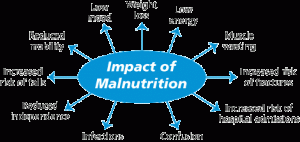
Malnutrition refers to deficiencies or excesses in nutrient intake, imbalance of essential nutrients or impaired nutrient utilization. The double burden of malnutrition consists of both undernutrition and overweight and obesity, as well as diet-related non-communicable diseases. Undernutrition manifests in four broad forms: wasting, stunting, underweight, and micronutrient deficiencies.
- Wasting is defined as low weight-for-height.
- Stunting is defined as low height-for-age
- Underweight is defined as low weight-for-age
- Micronutrient deficiencies are a lack of vitamins and minerals that are essential for body functions such as producing enzymes, hormones and other substances needed for growth and development.
Major nutrition supplementation programs in India are:
- Integrated Child Development Services Scheme (ICDS).
- Poshan Abhiyan (National Nutrition Mission).
- Mid-day meal Programs (MDM).
- Special Nutrition Programs (SNP).
- Wheat Based Nutrition Programs (WNP).
- Biofortification
- Balwadi Nutrition Programs (BNP).
- National Nutritional Anaemia Prophylaxis Program (NNAPP).
THE INTERNATIONAL RELATIONS
2. INDIA & ADB SIGN $300 MILLION LOAN
THE CONTEXT: The Government of India and the Asian Development Bank (ADB) signed a $300 million loan to strengthen and improve access to comprehensive primary health care in urban areas of 13 states that will benefit over 256 million urban dwellers, including 51 million from slum areas.
THE EXPLANATION:
- The programme supports the Government of India’s key health initiatives – Ayushman Bharat Health and Wellness Centres (AB-HWC) and Pradhan Mantri Atmanirbhar Swasth Bharat Yojana (PM-ASBY) – which has been renamed as Pradhan Mantri Ayushman Bharat Health Infrastructure Mission (PM-ABHIM) – by expanding availability and access to quality primary health care services particularly for vulnerable populations in urban areas.
- “Ensuring equitable access to non-COVID-19 primary health care is critical amid challenges posed by the coronavirus pandemic to India’s health system,” “The programme complements the government’s efforts to bridge the health care gaps by strengthening institutional capacity, operation, and management of urban health and wellness centers at the central, state, and municipal levels.”
- The programme will be implemented in urban areas across 13 states: Andhra Pradesh, Assam, Chhattisgarh, Gujarat, Haryana, Jharkhand, Karnataka, Madhya Pradesh, Maharashtra, Rajasthan, Tamil Nadu, Telangana, and West Bengal. Beside the pandemic response, interventions through the program promote increased utilization of urban HWCs with provision of comprehensive primary health care packages including noncommunicable diseases and community outreach services such as awareness raising activities on health care options, particularly for women.
- Delivery and health information systems for primary health care will be upgraded through digital tools, quality assurance mechanisms, and engagement and partnership with the private sector.
The programme is supported by a $2 million technical assistance grant from ADB’s Japan Fund for Poverty Reduction to provide support for programme implementation and coordination, capacity building, innovation, knowledge sharing and application of scalable best practices across the healthcare system.
Asian Development Bank (ADB)
- ADB is a regional development bank established in 1966, Headquartered at Manila, Philippines
- It has 68 members. India is a founding member. Forty-nine are from within Asia and the Pacific and 19 outside.
- It aims to promote social and economic development in Asia and the Pacific.
Voting rights:
- It is modeled closely on the World Bank and has a similar weighted voting system where votes are distributed in proportion with members’ capital subscriptions.
- As of 31 December 2020, ADB’s five largest shareholders are Japan and the United States (each with 15.6% of total shares), the People’s Republic of China (6.4%), India (6.3%), and Australia (5.8%).
Roles and functions:
- Dedicated to reducing poverty in Asia and the Pacific through inclusive economic growth, environmentally sustainable growth, and regional integration.
- This is carried out through investments – in the form of loans, grants and information sharing – in infrastructure, health care services, financial and public administration systems, helping nations prepare for the impact of climate change or better manage their natural resources, as well as other areas.
THE ENVIRONMENT AND ECOLOGY
3. THE LEGAL MANDATE FOR MSP
THE CONTEXT: Despite the announcement by Prime Minister committing to repeal the three farm laws, farmers have said their protest will continue — and have written to the PM with their six remaining demands, including, most importantly, a legal mandate for minimum support prices (MSP).
THE EXPLANATION:
- One of the key demands of the protesting farmers is that MSP be provided for all agricultural produce to every farmer.
- A legal mandate for MSP would force the government to purchase all the produce that any farmer wants to sell at the declared MSP. It would also have to procure from all states, and all crops for which MSPs are announced.
What is MSP?
- MSP is the minimum floor price at which the government procures from farmers and is calculated on the average cost of production.
- The committee proposed by the Centre will have representatives from Union and state governments, farmer groups as well as agricultural scientists and economists. Irrespective of the decision, a statutory guarantee to MSP will be a big step in agricultural marketing and procurement.
- The Commission for Agricultural Costs & Prices (CACP) recommends MSPs for 22 mandated crops and fair and remunerative price (FRP) for sugarcane. But effectively, it is maintained only for a few crops like paddy, wheat and soybean since there is no legal provision to implement the pricing. Sugarcane has legal sanction of fair and remunerative prices (FRP). In this case, the FRP is fixed by the government but paid by the mill owner.
Problem with this
- MSP guarantee will not work because there are variations in crop type, variations in yields in different regions and variations in support given to farmers across different states. So, if you guarantee something, it will lead to wrong cropping patterns tilted towards high yielding crops; 99 per cent of the farmers will shift to paddy cultivation, like what is already happening, irrespective of environmental factors, soil degradation and other factors.
- On the other hand, a guaranteed MSP can have quite a few unintended consequences that might make the attempted cure worse than the disease.
- In India, the percentage of people involved in agriculture is far higher, and they are far more economically distressed than any Western country. A legally mandated MSP regime is likely to be neither feasible nor sustainable in the long run. Already grain stocks lying with the government are more than twice its buffer requirement, and sometimes end up rotting.
Possible way forward
- The way forward is to ramp up investment in the agriculture sector. This means better irrigation facilities, easier access to credit, timely access to power, and ramping up warehouse capacity and extension services, including post-harvest marketing.
- The approach has to be to raise the farmers’ bargaining ability and choices before them. At a fundamental level, the problem is there are just too many people involved in Indian agriculture for it to be truly remunerative.
- Agriculture accounts for just 17% of India’s GDP while employing 55% of its population. To a great extent, the solution to the economic distress of Indian farmers lies outside agriculture — in boosting India’s industrial and services sectors. They are poor and indebted, and a large section among those who work in the fields are landless labourers. However, most Indian farmers have small and marginal landholdings, making them uneconomic.
4. THE AUSTRALIA’S BARRIER REEF CORAL SPAWNING
THE CONTEXT: Australia’s Great Barrier Reef is spawning in an explosion of colour as the World Heritage-listed natural wonder recovers from life-threatening coral bleaching episodes.
THE EXPLANATION:
- Scientists recorded the corals fertilizing billions of offspring by casting sperm and eggs into the Pacific Ocean off the Queensland state coastal city of Cairns.
- The network of 2,500 reefs covering 3,48,000 sqkm (1,34,000 square miles) suffered significantly from coral bleaching caused by unusually warm ocean
 temperatures in 2016, 2017 and last year. The bleaching damaged two-thirds of the coral.
temperatures in 2016, 2017 and last year. The bleaching damaged two-thirds of the coral.
What is coral spawning?
- Coral spawning is an annual event where corals simultaneously reproduce. During this synchronised breeding, coral polyps release millions of tiny egg and sperm bundles into the water. Each bundle must find another bundle from the same species to fertilise.
- Coral spawning is an annual event where corals simultaneously reproduce.
- During this synchronised breeding, coral polyps release millions of tiny egg and sperm bundles into the water.
- Each bundle must find another bundle from the same species to fertilise. By spawning on mass, corals increase the likelihood of finding and fertilising a matching bundle.
When does coral spawn?
- This depends on a number of factors including their location, the water temperature and tides.
- On the Great Barrier Reef, inshore reefs typically spawn in October, while outer reefs spawn during November or December.
- Spawning follows a full moon and water temperatures must have risen enough to stimulate the maturation of the egg and sperm bundles. The timing of spawning is also impacted by the length of the day, the tide and salinity levels in the water.
- Spawning only happens at night and lasts from a few days up to a week. Different species of coral spawn on different days to prevent crossbreeding.
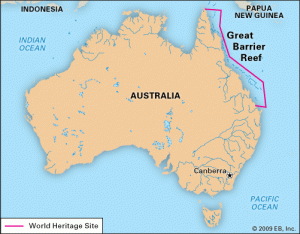
About Great Barrier Reef:
- The Great Barrier Reef is the world’s largest coral reef system composed of over 2,900 individual reefs and 900 islands.
- The reef is located in the Coral Sea (North-East Coast), off the coast of Queensland, Australia.
- The Great Barrier Reef can be seen from outer space and is the world’s biggest single structure made by living organisms.
- The reef structure is composed of and built by billions of tiny organisms, known as coral polyps. It was selected as a World Heritage Site in 1981.
Coral Bleaching:
- The stunning colours in corals come from marine algae called zooxanthellae, which live inside their tissues.
- This algae provides the corals with an easy food supply thanks to photosynthesis, which gives the corals energy, allowing them to grow and reproduce.
- When corals get stressed, from things such as heat or pollution, they react by expelling these algae, leaving a ghostly, transparent skeleton behind.
- This is known as ‘coral bleaching’. Some corals can feed themselves, but without the zooxanthellae most corals starve.
- Causes for Coral Bleaching include Change in Ocean Temperature, Runoff and Pollution, Overexposure to sunlight and Extreme low tides.
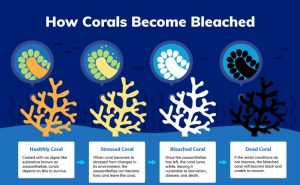
THE SCIENCE AND TECHNOLOGY
5. THE FASTEST SPIN OF WHITE DWARF
THE CONTEXT: In a record-breaking discovery, astronomers have discovered a white dwarf star that completes one rotation in just 25 seconds.
What are white-dwarf stars?
- White dwarf stars are the entities that form after stars like the Sun exhaust their nuclear fuel. This type of star expels most of its outer material near the end of its burning stage.
- Once the star burns out, only the core remains that reaches temperatures over 99,000 degrees celsius.
- According to NASA, a typical white dwarf is half as massive as the Sun, yet only slightly bigger than Earth.
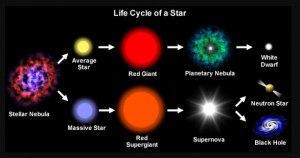
THE EXPLANATION:
- White dwarf star that completes a full rotation once every 25 seconds is the fastest spinning confirmed white dwarf, according to a team of astronomers.
- They have shown that it is an extremely rare example of a magnetic propeller system: The white dwarf is pulling gaseous plasma from a nearby companion star and flinging it into space at around 3,000 kilometres per second.
- It is only the second magnetic propeller white dwarf to have been identified in over 70 years, thanks to a combination of powerful and sensitive instruments.
- The new dwarf star is the 20 per cent faster than another confirmed white dwarf that completed a full rotation in just over 29 seconds. For the sake of comparison, one rotation of the planet Earth takes 24 hours.
- White dwarf stars are stars that have burnt up all their energy and shed its outer layers and now are undergoing a cooling or shrinking process over millions of years.
- The new dwarf star named LAMOST J024048.51+195226.9 — or J0240+1952 —is the size of the Earth estimated to be 200,000 times more massive. It is part of a binary star system. The star’s immense gravity is pulling plasma material from its larger companion star and putting it to spin. The materials in a white dwarf star can no longer undergo fusion reactions, so the star has no source of energy.
New white dwarf more massive than Earth
- The researchers were able to analyse this new white dwarf star using the HiPERCAM instrument of the world’s largest optical telescope-the Gran Telescopio Canarias in Spain.
- They found that although the star has a size similar to Earth but is nearly 200,000 more massive than our planet.
- Moreover, the observations also revealed that the star is pulling material from its nearby stars and scattering it all over space at a speed of about 3,000 kilometres/second.
Gran Telescopio Canarias
- Gran Telescopio Canarias (GTC), the largest optical telescope in the world, with a mirror that has a diameter of 10.4 metres (34.1 feet). It is located in the Canary Islands of Spain. The mirror consists of 36 hexagonal pieces, which can be moved separately from each other, and the shape of each piece can be changed.
- These two types of movements can compensate for the changes in the observed light that are caused by turbulence in Earth’s atmosphere.
THE GOVERNMENT SCHEMES/ INITIATIVES IN NEWS
6. THE ‘BHARAT GAURAV’ SCHEME
THE CONTEXT: To promote and attract tourism business, the Indian Railways launched Bharat Gaurav trains that will be operated by private players and run-on theme-based circuits.
What is the Bharat Gaurav policy?
- According to the Bharat Gaurav policy, any operator or service provider, or virtually anyone, can lease trains from Indian Railways to run on a theme-based circuit as a special tourism package.
- The tenure of the arrangement is a minimum of two years and maximum of the codal life of the coach. The operator has the freedom to decide the route, the halts, the services provided, and, most importantly, the tariff.
- The Bharat Gaurav operator will also have to propose a similar business model wherein it takes care of local transport, sightseeing, food, local stays, etc. along with operating the trains.
- The IRCTC runs such theme-based tourist trains, for instance, the Ramayana Express, which goes on a tour of several places connected to Lord Ram.
- These trains cannot be used as ordinary transport trains between an origin and destination.
‘Right of Use’ charge
- The annual ‘Right of Use’ charges calculated on the basis of the type of coach taken and the duration. In Bharat Gaurav scheme, the first year’s Right of Use charges have to be paid upfront and the second years have to be paid 15 days before the completion of the preceding year.
- Delay in payment would result in a penalty equivalent to the bank’s prevailing interest rate plus 3 per cent as administrative fee. If it is not paid within 30 days, the Right of Use may be terminated.
|
Do you know?
|
7. THE EXTENSION OF PRADHAN MANTRI GARIB KALYAN ANN YOJANA (PMGKAY)
THE CONTEXT: Union Cabinet has approved the extension of the Pradhan Mantri Garib Kalyan Anna Yojana (PMGKAY-Phase V) for a period of another 4 months i.e. December 2021 till March 2022.
THE EXPLANATION:
- In the wake of economic disruptions caused by the unprecedented outbreak of COVID-19 in the country, the Government in March 2020 had announced the distribution of additional free-of-cost foodgrains (Rice/Wheat) to about 80 Crore National Food Security Act (NFSA) beneficiaries at the scale of 5 Kg per person per month under the PM Garib Kalyan Anna Yojana (PM-GKAY).
- Phase-I and Phase-II of this scheme was operational from April to June 2020 and July to November 2020 respectively. Phase-III of the scheme was operational from May to June 2021. Phase-IV of the scheme is currently operational for July-November 2021 months.
- Pradhan Mantri Garib Kalyan Anna Yojana (PM-GKAY) under the Ministry of Finance is a scheme as part of Atmanirbhar Bharat to supply free food grains to migrants and poor.
Eligibility
- Families belonging to the Below Poverty Line – Antyodaya Anna Yojana (AAY) and Priority Households (PHH) categories will be eligible for the scheme.
- PHH are to be identified by State Governments/Union Territory Administrations as per criteria evolved by them. AAY families are to be identified by States/UTs as per the criteria prescribed by the Central Government:
- Households headed by widows or terminally ill persons, or disabled persons or persons aged 60 years or more with no assured means of subsistence or societal support.
- All primitive tribal households.
- Landless agriculture labourers, marginal farmers, rural artisans/craftsmen such as potters, tanners, weavers, blacksmiths, carpenters, slum dwellers, and persons earning their livelihood on daily basis in the informal sector like porters, coolies, rickshaw pullers, hand cart pullers, fruit and flower sellers, snake charmers, rag pickers, cobblers, destitutes and other similar categories in both rural and urban areas.
- All eligible Below Poverty Line families of HIV positive persons.
8. THE CONTINUATION OF “OCEAN SERVICES, MODELLING, APPLICATION, RESOURCES AND TECHNOLOGY (O-SMART)”
THE CONTEXT: The Cabinet Committee on Economic Affairs chaired by the Prime Minister gave its approval for continuation of the umbrella scheme “Ocean Services, Modelling, Application, Resources and Technology (O-SMART)” of Ministry of Earth Sciences, for implementation during the period from 2021-26 at an overall cost of Rs. 2177 crore.
THE EXPLANATION:
- The O-SMART scheme encompassing oceanographic research activities is being implemented with the objectives for providing forecast and services based on the continuous observation of our oceans, development of technologies and exploratory surveys for sustainable harnessing of our oceanic resources (both living and non-living) and promotion of front-ranking research in ocean sciences.
- Several major milestones have been achieved through the activities of the scheme, the most significant is India’s recognition as Pioneer Investor with International Seabed Authority (ISA) for conducting extensive research on deep sea mining of Poly Metallic Nodules (PMN) and hydrothermal sulphides in the allotted area of the Indian Ocean.
- The technology development for desalination using low temperature thermal desalination installation of such facility in Lakshadweep islands is also a significant achievement.
- Moreover, India’s ocean related activities are now extended from the Arctic to Antarctic region covering large ocean space which have been monitored by through in-situ and satellite-based observation. India has taken leadership role in implementing Indian Ocean component of Global Ocean Observing System in Intergovernmental.
Objective of O-SMART Scheme:
- The Scheme generates and regularly update information on Marine Living Resources and their relationship with the physical in Indian Exclusive Economic Zone (EEZ).
- Periodically monitors water levels of sea pollutants for health assessment of the coastal waters of India. To develop shoreline change maps for the assessment of coastal erosion.
- Develop a wide range of state-of-art ocean observation systems for the acquisition of real-time data from seas around India.
- Develop High-resolution models for the ocean forecast and reanalysis systems.
O-SMART is implemented by the following five institutes of the MoES.
- National Institute of Ocean Technology (NIOT), Chennai
- Indian National Centre for Ocean Information Services (INCOIS), Hyderabad
- National Centre for Coastal Research (NCCR), Chennai
- Centre for Marine Living Resources & Ecology (CMLRE), Kochi
- National Centre for Polar and Ocean Research (NCPOR), Goa.
What is the Significance of the O-SMART Scheme?
- OSMART being a multidisciplinary continuing scheme, the ongoing extensive research and technology development activities would augment capacity building of the nation in the oceanographic field at the international level. The present decade has been declared as the Decade of Ocean Science for Sustainable Development by the United Nations (UN) and continuation of the scheme would strengthen our stand in the global oceanographic research and technology development.
- This continuation of the scheme would contribute significantly towards national policy on blue economy for effective and efficient use of the vast ocean resources in a Sustainable way. Efforts towards achieving United Nations sustainable Development Goal-14 to conserve and sustainably use the oceans, seas and marine resources are being covered through the coastal research and marine biodiversity activities.
- Significant contribution to the national GDP is being made and to be continued through the ocean advisory services and technologies developed benefiting communities and several sectors working in the marine environment, particularly in the coastal states of India.
In the next five years (2021-26) this scheme would provide further comprehensive coverage through strengthening the ongoing activities towards delivering cutting edge technology applicable for marine domain, forecast and warning services to various coastal stake holders, understanding biodiversity towards conservation strategy for marine living organisms and understanding coastal processes.
9. THE PROACTIVE GOVERNANCE AND TIMELY IMPLEMENTATION (PRAGATI)
THE CONTEXT: Prime Minister chaired the meeting of 39th edition of PRAGATI, the ICT based multi-modal platform for Pro-Active Governance and Timely Implementation, involving Centre and State governments
THE EXPLANATION:
- In the meeting, nine agenda items were taken for review including eight projects and one scheme.
- Among the eight projects, three projects were from the Ministry of Railways, two projects each were from the Ministry of Road Transport & Highways and Ministry of Power and one project was from the Ministry of Petroleum & Natural Gas.
- These eight projects, having a cumulative cost of about Rs. 20,000 crores are concerning seven states viz., Bihar, Madhya Pradesh, Rajasthan, Andhra Pradesh, Gujarat, Maharashtra and West Bengal. Prime Minister stressed upon timely completion of projects to avoid cost overruns.
- During the interaction, the Prime Minister also reviewed Poshan Abhiyaan. He said that Poshan Abhiyan should be implemented in mission mode in each state with a whole of government approach. He also talked about participation of Self-Help Groups (SHGs) and other local organizations in promoting awareness about children’s health and nutrition at the grassroot level, which will help in improving the reach and uptake of the Abhiyaan.
About PRAGATI:
- PRAGATI is an Information and Communication Technology (ICT) platform existing in the Prime Minister’s Office (PMO), that reviews and monitors various Government Projects across the country.
- It was launched in 2015, designed by PMO with the help of National Informatics Centre (NIC).
The three objectives of PRAGATI are:
- Grievance Redressal
- Programme Implementation
- Project Monitoring
Importance:
- The PRAGATI platform uniquely bundles three latest technologies: Digital data management, video-conferencing and geo-spatial technology.
- It promotes cooperative federalism as it brings on one platform the Secretaries of Government of India and the Chief Secretaries of the States.
- However, the direct interaction of the PM with the state secretaries without involving the political executives of the states is undermining the State political executive. It is also said that this is leading to a concentration of power in the extra-constitutional office of PMO.
- It is a robust system for bringing e-transparency and e-accountability with real-time presence and exchange among the key stakeholders.
- It is an innovative project in e-governance and good governance.
PRELIMS PRACTICE QUESTIONS
Q 1. Legislation that confers on the executive or administrative authority an unguided and uncontrolled discretionary power in the matter of the application of law violates one of the following Articles of the Constitution of India?
a) Article 14 b) Article 28
c) Article 32 d) Article 44
ANSWER FOR NOVEMBER 24th, 2021 PRELIMS PRACTICE QUESTIONS
1. ANSWER: A
EXPLANATION:
- The ‘Common Carbon Metric’, supported by UNEP, has been developed for assessing the carbon footprint of building operations around the world.

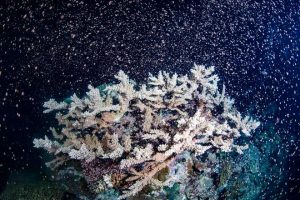 temperatures in 2016, 2017 and last year. The bleaching damaged two-thirds of the coral.
temperatures in 2016, 2017 and last year. The bleaching damaged two-thirds of the coral.